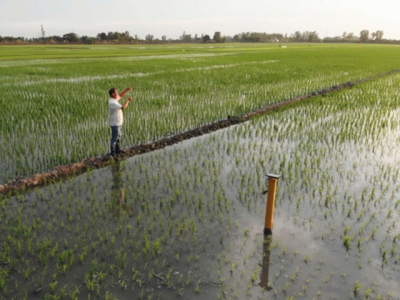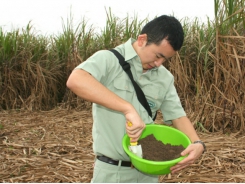Alternating wetting and drying (AWD) helps Mekong Delta rice farmers cope with droughts

Alternate Wetting and Drying (AWD) is a water-saving technology that farmers can apply to reduce their irrigation water consumption in rice fields without decreasing its yield. The technology can help save up to 30 per cent of water and reduce up to 48 per cent of methane emissions.
AWD combined with IoT brings remarkable efficiency, helping farmers save additionally 13 – 20 per cent of water amount compared to manual AWD. Photo: Minh Dam.
If the majority of farmers can master and apply this technique proficiently, it will be able to reduce the burden of watering in the dry season for other crops and livestock as well as help rice farming more sustainable.
Once deploying AWD, when the rice is at the stage of fertilizing, farmers put water in the field about 5-10cm. After that, when the water level is 10-15cm lower than the field surface, the farmers add water into the field. This technology is implemented through an automatic water level measuring device placed in the field.
However, at present, most farmers are still unaware of this technique. Farmers still maintain the habit of taking water into the field based on feelings without scientific basis. Seeing this fact, Tra Vinh University has implemented the project "A supporting tool based on Sentinel satellite data to certify sustainability in rice farming".
The project objective is to ensure that complete and reliable on-site reference data are collected from the field to develop and validate Sentinel satellite data-based monitoring of irrigation water management practices in rice farming with alternating wetting- drying technology in the Mekong Delta.
The project will be implemented in two years from February 2021 to November 2022 (4 rice crops) in 3 provinces and cities - Can Tho, An Giang and Tra Vinh. Up to now, the project has completed phase 1 with summer-autumn and autumn-winter crops.
Assoc. Prof. Dr. Diep Thanh Tung, Vice Rector of Tra Vinh University, project leader, said that due to the complicated situation of the Covid-19 pandemic, they were unable to conduct a survey, preliminary review and evaluation of effectiveness in the first phase . However, preliminary statistics on the use of water for irrigation by AWD method show that most of the farmers participating in the project are conscious of saving water for irrigation in rice cultivation.
The first time farmers participating in the project and not having much experience in the application of AWD technology are more cautious about keeping the fields too dry as recommended. For example, instead of letting the field dry up to -10cm, people confidently let it dry to -6, -7cm and then pumped water in. Although this practice cannot optimize water use efficiency in rice farming, it is still acceptable as optimal farming conditions for AWD in many places are still not guaranteed.
Tra Vinh province is a downstream coastal province in the Mekong Delta, the locality most strongly affected by climate change. The hot season usually comes earlier than other localities. In the dry season of 2020, some areas of winter-spring rice at the beginning of the crop lack water for irrigation. Last summer-autumn crop 2021, Tra Vinh University instructed AWD technology to farmers in Phu Can commune, Tieu Can district, Tra Vinh province.
Duong Van Tuan in Cau Tre hamlet, Phu Can commune, Tieu Can district, said that he had 7,000m2 of rice land involving in the project.
“Previous years, during Tet, there was still fresh water. Now, salt water intrusion appears before Tet. Lack of irrigation in the fields leads to weaker rice growth,” he said.
In the past, whenever seeing field get a little bit dry, farmers added water in
“This model greatly saves water,” he said, adding that when applying this irrigation technology, he saved about 30 per cent of water compared to before.
Recently, Tuan's rice yield reached six tons/ha. The whole family is very excited because the summer-autumn rice crop has high productivity.
AWD combined with IoT increases productivity, saves water for irrigation
Tra Vinh University has also made a device to measure water levels in the field using IoT (Internet of things) technology. This technology allows users to manage the water level in the field through the management software set up on the mobile device. Through it, users can control and start the pump from their mobile phone to let water into the field when the water level is below the threshold of AWD.
As a result, AWD combined with IoT brings remarkable efficiency, helping farmers save additionally 13 – 20 per cent of water amount compared to manual AWD. Besides, AWD with IoT helps them save energy and time. In the final stage, IoT application generated higher productivity than manual AWD with an increase of more than 11 per cent in Can Tho and nearly five per cent in Tra Vinh and An Giang . Farmers have expressed a desire to continue using this technology.
According to Assoc. Prof. Dr. Nguyen Thai Son, Dean of Faculty of Engineering and Technology (Tra Vinh University), AWD combined with IoT helps farmers save irrigation water by 13 – 20 per cent compared to manual AWD, saving costs for pumping from 24 to 50 per cent depending on the characteristics of the cultivated land and saves farmers' labor. In particular, the project also helps farmers increase productivity by 3 – 12 per cent.
Le Hoang Viet, an officer of the VnSAT An Giang Project Management Board, said that realizing the benefits of IoT in water-saving irrigation using sensors, An Giang has coordinated with Tra Vinh University to organise a training workshop for 20 agricultural technicians at Tan Loi Cooperative and 3 ha pilot here. The implementation in the winter-spring crop 2018 - 2020 generated good results, helping to save irrigation pumping costs and ensure productivity.
With the results achieved in An Giang, Tra Vinh University has coordinated with the VnSAT An Giang Project Management Board and the Agricultural Extension Station to deploy the SentiRice project sponsored by the European Space Agency. Accordingly, three fields are selected to implement IoT application model for "1 must 5 reduce" and control 15 fields of farmers in Vinh Khanh Cooperative, Vinh Khanh commune, Thoai Son district. Under the model, IoT technology is used to control irrigation and remote sensing techniques to assess the development of rice. The model will be implemented from 2021 to 2022 through 3 rice crops.
Có thể bạn quan tâm
Phần mềm

Phối trộn thức ăn chăn nuôi

Pha dung dịch thủy canh

Định mức cho tôm ăn

Phối trộn phân bón NPK

Xác định tỷ lệ tôm sống

Chuyển đổi đơn vị phân bón

Xác định công suất sục khí

Chuyển đổi đơn vị tôm

Tính diện tích nhà kính

Tính thể tích ao hồ



 Agricultural services company to help make farming safer
Agricultural services company to help make farming safer  The soil nutrient map helps to save fertilizers
The soil nutrient map helps to save fertilizers